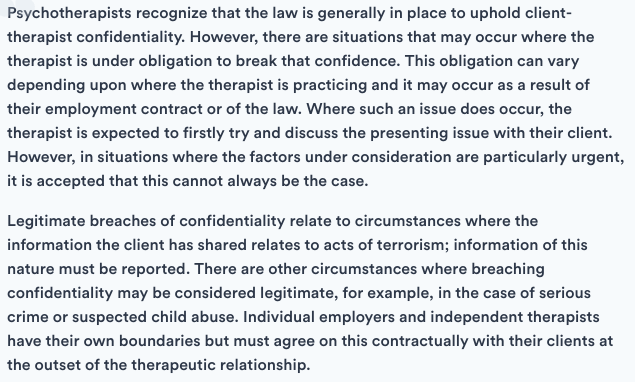Explanation:
The text suggests that detailed study schedules may not be necessary for achieving the best results. It mentions that some students prefer shorter study sessions or a top-down learning approach, which are believed to be effective.
Explanation:
Top-down learning, as described in the text, involves starting with an overview of topics or concepts before delving into the details. This approach is considered natural because it mirrors how many people naturally approach understanding complex subjects: by first grasping the big picture before focusing on specifics.

Explanation:
The law is one reason why someone would have to break confidentiality, but their employment contract is another reason why this could occur. '..and it may occur as a result of their employment contract or of the law.'
Explanation:
The passage states 'Legitimate breaches of confidentiality relate to circumstances where the information the client has shared relates to acts of terrorism; information of this nature must be reported.'
Explanation:
The last sentence talks about the fact that ‘individual employers and independent therapists have their own boundaries but must agree this contractually with their client at the outset of the therapeutic relationship.’ This therefore means that they do have some flexibility regarding what they deem to be serious enough.
Explanation:
This cannot be true as we are told in paragraph one that universities were the only places that had sufficient engineering knowledge to be able to deliver the level of research that was required to support such objectives [innovation in next-generation technology advances at the intersection of disciplines].
Explanation:
In the first paragraph we are told that the key focus was on innovation in next-generation technology advances at the intersection of disciplines. ‘Intersection’ means junction or joining point therefore the answer must be True. If we are talking about the intersection of disciplines, we must be referring to multiple disciplines.
Advertisement
Explanation:
The second generation of ERCs were encouraging collaboration across universities therefore this statement must be false. They did encourage universities to work more collaboratively with one another.
Explanation:
We know that people in this survey are less likely to have ‘mixed-use assets’ (an add-on to commercial investment). Our gut reaction to this may therefore be to say ‘False’ but the passage is only telling us that the people in the survey are less likely to have residential holdings that form part of mixed use assets. We don’t know whether these people own the businesses that run from the commercial premises. The answer is therefore ‘Cannot tell’.
Explanation:
This is false because, in the final paragraph, we are told that ‘uncovering longer-term intentions was also part of the survey remit..’ so why people invest was one of the multiple objectives of the survey.
Explanation:
We have no means of knowing whether the people who responded to the survey were representative of the wider population of property investors. We know that the survey was conducted by a large insurance company but they may have been a very niche group of people. The answer is Cannot tell.